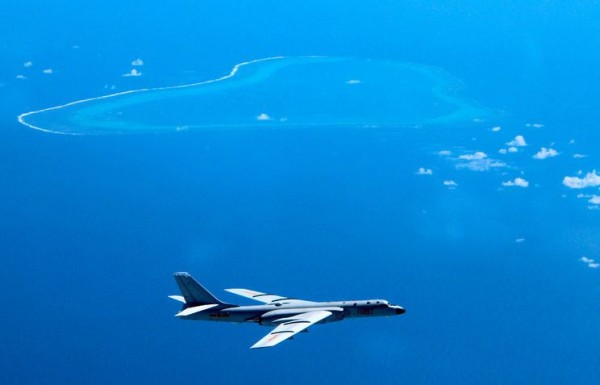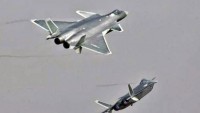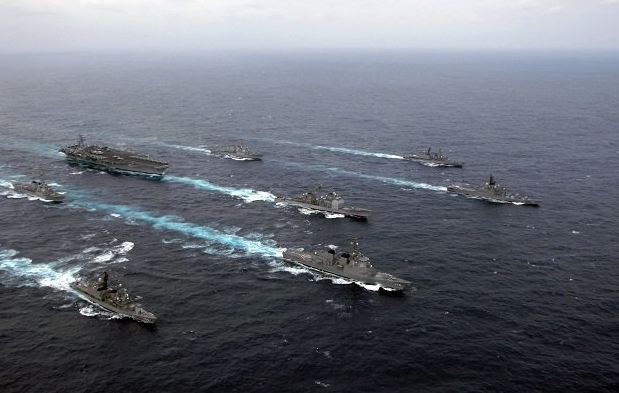China says Japan and South Korea can Expect Larger Military Air Patrols Close to their Airspace
| Arthur Dominic Villasanta | | Jan 12, 2017 08:48 AM EST |
(Photo : Xinhua) H-6K bomber over the South China Sea.
The largest aerial patrol of Xian H-6 medium-range jet bombers that triggered interceptions by the air forces of Japan and South Korea on Jan. 9 will be followed-up by even larger patrols, said the People's Liberation Army Air Force (PLAAF).
PLAAF confirmed a formation of six of its H-6s flew in international airspace perilously close to the air defense zones of both Japan and South Korea.
Like Us on Facebook
This patrol represents the largest number of H-6 bombers in a single patrol so far. PLAAF operates some 140 of these bombers, most of which are conventional bombers armed with bombs and cruise missiles although some might be able to deliver nuclear bombs.
The People's Liberation Army Navy (PLAN) operates about 30 of these bombers, many of which are armed with anti-ship missiles.
The Japan Air Self-Defense Force (JASDF) sent its fighters to monitor this PLAAF bomber formation its radars detected flying over the East China Sea and Sea of Japan. It said its radars detected 10 PLAAF aircraft and not six.
The Republic of Korea Air Force (ROKAF) sent 10 of its F-15K and KF-16 fighter jets to keep an eye on the Chinese bomber formation. The former is the Korean version of the McDonnell-Douglas F-15 Strike Eagle multirole fighter while the latter is Korea's version of the General Dynamics F-16 Fighting Falcon air superiority fighter.
In the past, PLAAF show the flag aerial patrols have triggered alarms in either Japan or South Korea but not both at the same time. This new tack seems to say the PLAAF isn't scared of either the JASDF or the ROKAF.
More ominous for both air forces was PLAAF's post-patrol statement it will definitely continue these danger close patrols and will not place a limit on the size of future formations.
The People's Liberation Army (PLA) described the Jan. 9 aerial patrol as a "ship-aircraft coordination training" between PLAAF and PLAN.
It claims the mission was a routine arrangement in the annual training plan and didn't target any specific country or region. The training was consistent with relevant international laws and practices and will be continued in the future.
TagsPeople's Liberation Army Air Force, Xian H-6, Japan, South Korea, People's Liberation Army Navy, Japan Air Self-Defense Force, Republic of Korea Air Force
©2015 Chinatopix All rights reserved. Do not reproduce without permission
EDITOR'S PICKS
-

Did the Trump administration just announce plans for a trade war with ‘hostile’ China and Russia?
-

US Senate passes Taiwan travel bill slammed by China
-

As Yan Sihong’s family grieves, here are other Chinese students who went missing abroad. Some have never been found
-

Beijing blasts Western critics who ‘smear China’ with the term sharp power
-

China Envoy Seeks to Defuse Tensions With U.S. as a Trade War Brews
-

Singapore's Deputy PM Provides Bitcoin Vote of Confidence Amid China's Blanket Bans
-

China warns investors over risks in overseas virtual currency trading
-

Chinese government most trustworthy: survey
-

Kashima Antlers On Course For Back-To-Back Titles
MOST POPULAR
LATEST NEWS
Zhou Yongkang: China's Former Security Chief Sentenced to Life in Prison

China's former Chief of the Ministry of Public Security, Zhou Yongkang, has been given a life sentence after he was found guilty of abusing his office, bribery and deliberately ... Full Article
TRENDING STORY

China Pork Prices Expected to Stabilize As The Supplies Recover

Elephone P9000 Smartphone is now on Sale on Amazon India

There's a Big Chance Cliffhangers Won't Still Be Resolved When Grey's Anatomy Season 13 Returns

Supreme Court Ruled on Samsung vs Apple Dispute for Patent Infringement

Microsoft Surface Pro 5 Rumors and Release Date: What is the Latest?













